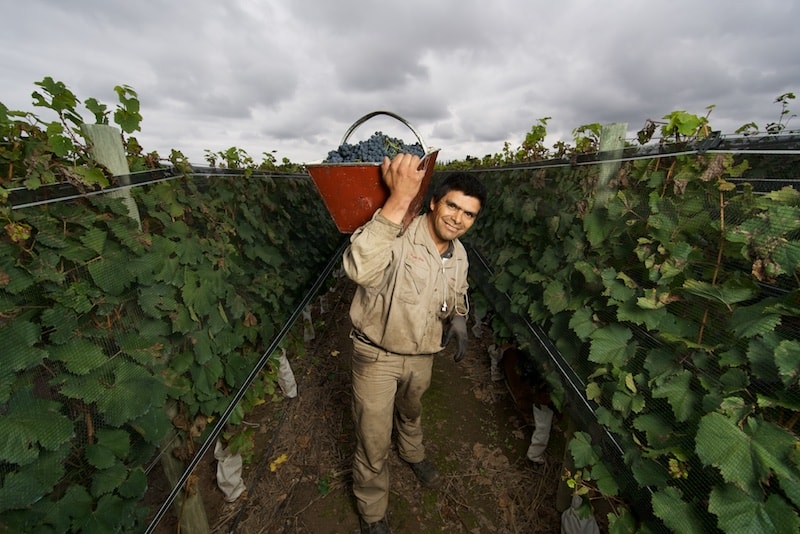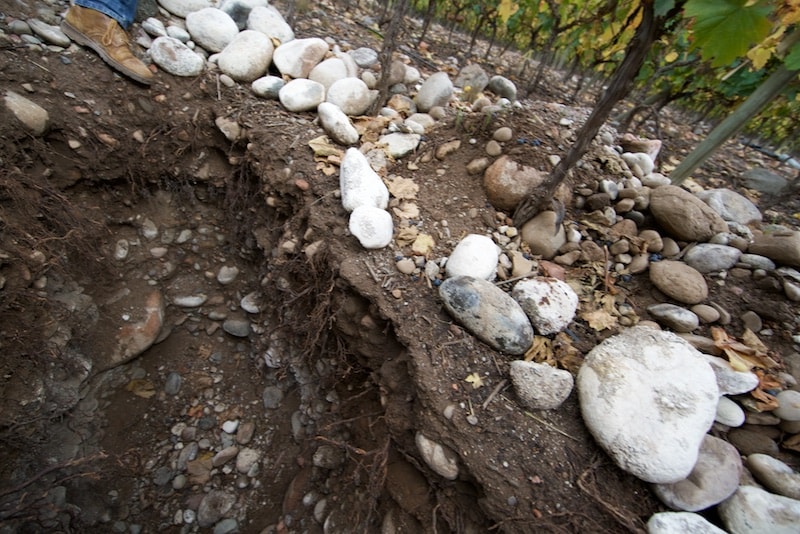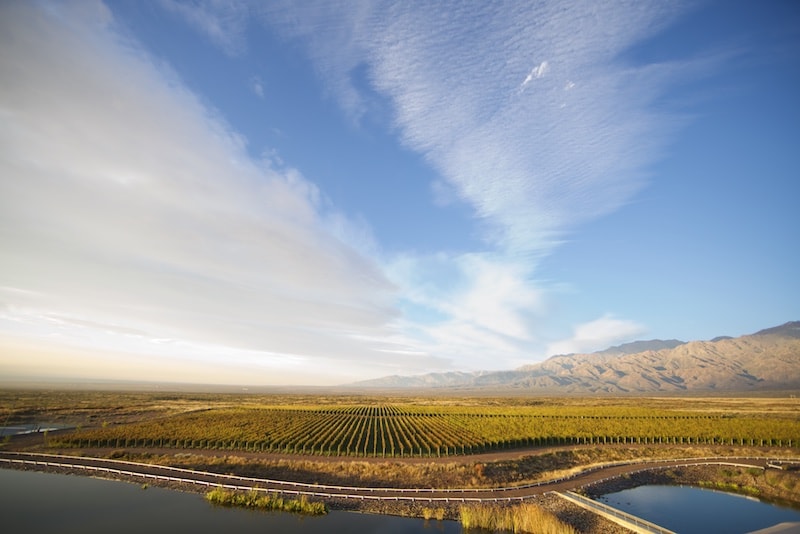Mendoza’s Uco Valley is hogging the limelight in South America and with good reason. It still often gets described as the ‘up and coming’ region of Argentina, but make no mistake – it has firmly arrived. And the Uco Valley is here to stay…. Get the inside scoop on the wine regions, winemakers and wines with our complete Uco Valley guide.

Harvesting in the Uco Valley*
How Mendoza became South America’s largest wine region…
The history
Mendoza produces over 70% of Argentina’s wines, making it the largest wine region in South America. It is, in fact, one of the largest wine regions in the world. Mendoza has more vineyards planted than all of South Africa‘s wine regions put together.
It is the heart of Argentine wine and its arteries run deep and pulse fast, supplying wine all over the country and around the globe. If you have only had one Argentine wine, it is most likely that it came from Mendoza. (It is, however, less likely to have come from the Uco Valley which, despite its fame, makes just 8% of Mendoza’s wine.)
Why has Mendoza become such a significant wine producer? Well, the reasons are partly to do with history and partly to do with climate.
The first vines planted in Argentina, according to top Argentine historian Felipe Pigna, were planted 900km away from Mendoza in Santiago del Estero, the oldest city in Argentina, which was founded in 1553. The region is hot and humid, which was fine for making cheap wine (and, more importantly during those days, wine for the church) but quality production was naturally limited.
It wasn’t until the Spanish brought vines across from Chile a few years later that Mendoza was established as a wine region. In the 1570s wine production began to expand along the spine of the Andes mountains from north to south hugging the western border of Argentina.
Mendoza’s location, just 180km from Santiago, Chile, afforded it an important connection and established it as a trade route early on. The railway line built in 1885 linked winery cellars in Mendoza directly to taverns and bars in Buenos Aires. But its climate is what has continued Mendoza’s legacy as a global wine capital.

Mendoza has a 500 year history of winemaking
The climate of Mendoza: an oasis in the desert
In the rain shadow of the Andes mountains, Mendoza has a continental climate with some of the hottest and driest conditions in the world. Days are warm and sunny, and nights are cool and clear. It experiences on average 320 days of sunshine a year, and around 200mm of rainfall annually. Disease is rarely a problem and, so long as you have water, you can produce quality wines with ease and relatively cheaply.
Irrigation channels were created long before the first vines were planted. The native Huarpe people created pre-Columbian canals to bring water from the Andes mountains and its rivers to the flat, fertile land of Mendoza in order to cultivate their own crops. When the Spanish missionaries arrived, they were able to use the ancient acequias (waterways) to cultivate vines and continued to expand the irrigation system over larger distances.
Mendoza truly is an oasis in the desert. Only 4% of Mendoza is cultivated, the rest of the province is still arid desert. However, that 4%, of which is 160,000 hectares is dedicated to vines, makes quite a lot of the world’s wine.
Mendoza’s wine regions
Within Mendoza there are several wine regions of note, as well as some that will barely register with most international wine drinkers. Most production comes from regions just east of Mendoza. More than half of Mendoza’s wine production comes from San Martín, Rivadavia, Lavalle and Junín: four regions bordering Mendoza city to the east and north. They are hotter regions known for making bulk and table wine.
The next region in production size is Maipú, making 8% of Mendoza’s wines. Just south east of Mendoza city centre, its warm, flat lands (that are conveniently close to the main local population) made it the natural first choice for the modern wine industry. Maipú is where you will find the largest historical wineries in Argentina.
A bit further south and to the west is Luján de Cuyo, the cradle of Malbec. Luján de Cuyo also covers a vast area (and makes 7% of the region’s wines) but it is closer to the Andes and and at a higher elevation than Maipú, giving it cooler temperatures in general. This is the region that really put Mendoza on the map for quality Malbec. With many distinctive micro regions and some world-class producers, there is lots to explore in Luján and it was the shining star of Argentine wine – until the Uco Valley took its crown.
Other regions in Mendoza include San Rafael and General Alvear in the south; Santa Rosa and La Paz to the east; Las Heras to the north; and Godoy Cruz and Guaymallén on the outskirts of the city. The other regions (San Carlos, Tunuyán and Tupungato) all fall into the umbrella of the Uco Valley, over 80km south of Mendoza.
The promised land: the Uco Valley

A view to the Andes (Vines of Mendoza)
Why is the Uco Valley so hot right now? It’s precisely because it’s so cool. Over the last few decades Mendoza has been getting increasingly warm as climate change plays its part. The style of wines we drink today has also changed.
While a hundred years ago the warmer eastern regions of Mendoza were great for producing large productions of cheap wine, today winemakers (and arguably consumers) want something different. That’s what the Uco Valley offers Mendoza: a different wine dimension.
Although the drive to the Uco Valley feels relatively flat (to be honest anything does when you glance over at the towering Andes to the side), it has more of a mountain influence than any of the other wine regions in Mendoza.
With altitudes reaching up to 1700m (compared to 800m in Maipú for example), the temperatures can be more than 10°C cooler in the day than in Mendoza. And the temperature at night is usually at least 15°C less than the daytime temperature. This wide thermal amplitude gives Uco Valley wines an intensity of colour, phenolics and tannin, while retaining the grapes’ natural acidity. And it is the acidity resulting from the altitude that is key to the character of Uco Valley wines, and what differentiates them to other Mendoza wines (which are all rich in colour and tannin).
The Uco Valley is also the only area in Mendoza where the climate is cool enough to be classified as Category II on the Winker Scale (in parts of Gualtallary and Vista Flores). This has led winemakers to plant grape varieties that prefer cooler temperatures, including Pinot Noir and Chardonnay, with some success.
The other impact of being closer to the mountains is the soil. Some of the Uco Valley’s most prized appellations are located on alluvial fans from the Andes mountains. These bring a complex mix of soils, including stones, sand and, the most prized of all, limestone. The combination of these poor, mountain soils and the low rainfall (just 83mm annually in Gualtallary!) means that irrigation is essential.

Alluvial soils with Calcium Carbonate in Altamira*
The Uco Valley’s isolation from the other, more populous, wine regions in Mendoza has also been one of its greatest assets over time. The Uco Valley is also a prime fruit-growing region and it is one of the only regions in Argentina to have not been affected by the Mediterranean fruit fly. Originally its isolated location was enough to keep the insects at bay, but as movement between the Uco Valley and Mendoza’s capital has increased, the risk of stowaway flies is greater and so anyone or anything that comes into the valley is controlled at frequent check points.
Its isolated location, while beneficial for healthy viticulture, meant that early investments were extremely costly. There have been small family-owned vineyards in the Uco Valley for centuries, but during most of the 20th century there were no large producers to compare with those closer to the city. When the first large producers started establishing themselves in the valley in the late 90s, the initial capital needed to build the roads and infrastructure for large wineries ran into the millions (of dollars, and pesos).
Most of the pioneers of the modern Uco Valley wine industry were funded by foreign capital from Europe, the US and even neighbouring Chile. While some were taking advantage of the downtrodden state of Argentina’s economy at the time, the majority were attracted by the vast unexplored potential of the Uco Valley.
These pioneers paved the way for many other producers and there is now a myriad of different-sized producers in Uco from all sorts of backgrounds. Although a lot of the infrastructure is in place today, it still isn’t cheap. Land in the Uco Valley costs around US$40,000 a hectare. But producers think it is worth it, and the property market is still booming.
The very success of the Uco Valley is its biggest threat though. As more investment and producers pour into the valley, it is losing its isolation factor and resources are becoming scarce.
The pure water from Andean snow melt is one of the great assets of the Uco Valley, and essential for any life in what is, ultimately, a desert. The more people and plantations there are, the less water there is to go around and that lack of water is already having an impact. Numerous ambitious projects are on hold because of the lack of water. Wine producers have bought the land, but until – or if – they are granted the water rights by the government, they can’t do anything. And unfortunately as this is a country with deeply rooted corruption, getting those rights in Argentina can take an unpredictable length of time.
Those who do make it in the Uco Valley can, however, be sure they will enjoy a privileged position at the forefront of New World winemaking.
A taste of the future in Argentina:
Uco Valley guide to the regions, wines & winemakers
Ever since modern producers moved into the Uco Valley, they have been defining the tastes of the top shelf in Argentina. From rich, concentrated Malbecs through to electric, acidity-driven Pinot Noir, here are the top three wine regions, the wines and the producers you need to know about:
Paraje Altamira GI

The view from Zuccardi’s Altamira vineyard
The first Geographical Indication (appellation) in Argentina that looked at soil mapping and studies to plot out the boundaries, Paraje Altamira GI is remarkable for many reasons. Based on an alluvial cone over 1000m above sea level, Altamira’s vineyard soils contain a mix of sand, limestone, glacial rocks and gravel, with a deep base of calcium carbonate deposits. It is this unique streak of limestone that many winemakers believe make it the most prized appellation in the Uco Valley.
The Wines: Paraje Altamira
As with all of Argentina’s wine regions, Malbec is the King in Altamira. However it tends to be more perfumed, with floral notes of violet and lavender and aromatic red fruits on the nose and a vertical, mineral mouthfeel with good length.
Beyond Malbec, Altamira has been gaining ground for its renowned, although small, production of Cabernet Franc. It also has notable Cabernet Sauvignon and Bonarda. In white wines the best varieties are Chardonnay and some Semillon.
The Producers & Winemakers: Paraje Altamira
Sebastián Zuccardi

Sebastian Zuccardi*
While the Zuccardi family make wines in many different regions of Mendoza, the exploration and the major investment they have made in their new family winery has been important for the region. From the third generation of the family, Sebastián Zuccardi is a leading voice among the new generation of winemakers in Argentina. He has been influential in his approach to site-specific winemaking and also experimentation in winemaking techniques.
Top Zuccardi Altamira wines to try: Finca Piedra Infinita (Malbec); Alluvional Paraje Altamira (Malbec); Emma Zuccardi Paraje Altamira (Bonarda); Concreto (Malbec).
- Discover the different expressions of Malbec around the Uco Valley with Sebastián Zuccardi in this video tasting and interview.
- Learn about dirt with this Uco Valley guide to the terroir, from a soil pit in Paraje Altamira with Sebastián Zuccardi.
Other recommended Altamira wines to try:
Altos Las Hormigas Appellation Altamira (Malbec); Bodega Teho Toko Vineyard (Malbec, and Cabernet Franc); Mendel Finca Remota (Malbec) and Mendel Semillon; SuperUco Calcáreo Coluvio (Malbec); Susana Balbo Barrel-Fermented Torrontés (and White Blend); PiPA (Independent Producers of Paraje Altamira).
Gualtallary

Gualtallary from Doña Paula’s vineyard
With the highest altitudes in the Uco Valley and poor rocky soils riddled with limestone, Gualtallary is one of the most sought-after regions in Argentina. There are few places in Mendoza where you get hillsides, but Alto Gualtallary is one of them.
The Wines: Gualtallary
The added altitude means this is a top spot for sparkling and white wines as well as Malbec. However the Malbec is also world-class: typically with a more mineral, herbal and floral expression than elsewhere in Mendoza. You are more likely to pick up notes of graphite and wild thyme than overripe plum in these wines. Gualtallary Malbec and, indeed, all the wines from this area, have an electric acidity as a backbone which frames it as a vertical wine with a lasting finish.
Other reds of note in Gualtallary include Cabernet Franc and Pinot Noir, which both benefit from the fresh acidity. Top whites are Chardonnay, Sauvignon Blanc and even some Riesling, that are complimented by the production of good sparkling wine.
The Producers & Winemakers:
Matías Michelini

Matias Michelini*
If there’s one person who has been advocating Gualtallary more than any other, it is Matias Michelini. Michelini blazed a trail for his generation of winemakers, not only in location, but in style. In Gualtallary he found a connection with his own personal wine style: acidity-driven wines with tension. At that time Mendoza was saturated with overripe, rich wines with low acidity, and so Michelini and Gualtallary went hand-in-hand for this new, fresher style. He has been an important figurehead not just in reds, but also with powerful whites (Semillon, Sauvignon Blanc) and is so far the only orange wine producer in Mendoza. While Michelini consults for many wineries in the Uco Valley today, the most creative wines are found in his own biodynamic wine brand Passionate Wine. His whole family are wine producers today (in SuperUco) and two of his brothers, Juan Pablo (Zorzal winery) and Gerardo (Gen de Alma), have strong followings too.
Top Michelini family Gualtallary wines to try: Demente (Malbec/CF blend); Eggo Tinto de Tiza (Malbec/CS/CF blend); Agua de Roca (Sauvignon Blanc); JiJiJi (Malbec/Pinot Noir blend).
Catena Zapata

Vineyard Manager Luis Reginato*
Nicolás Catena began planting his vineyard in Alto Gualtallary in the early 90s. At that time, few winemakers in Mendoza were prepared to risk going to such a high altitude, but he believed it had great potential. Since then the Catena Zapata wine group has been hard at work making excellent Chardonnay (White Bones & White Stones), Cabernet Franc and Malbec (both Adrianna Vineyard) from the region. Head Winemaker Alejandro Vigil also makes great Chardonnay, Cabernet Franc and Malbec wines from Gualtallary under his own brand El Enemigo, while Nicolás’ daughter Laura Catena also makes top Chardonnay and Pinot Noir from Gualtallary under her Luca label.
- What makes Gualtallary’s soils so special for Chardonnay? Catena Zapata Vineyard Director and winemaker Luis Reginato takes us on a soil pit tour and tasting of White Bones and White Stones.
- Learn about the history of Malbec in Argentina with Laura Catena in this video interview.
Other recommended Gualtallary wines to try:
PerSe La Craie (Malbec/CF); Doña Paula Alluvia Bush Vines (Malbec); Alto Las Hormigas Appellation Gualtallary (Malbec); Zuccardi Alluvional Gualtallary (Malbec); Revolver Chardonnay and Malbec; Doña Paula Estate Riesling; Sophenia Synthesis (Sauvignon Blanc).
Vista Flores

Casa de Uco in Vista Flores*
This is where the Uco Valley wine train really got rolling. It is the region with the biggest wine and tourism development and the top destination on any visitor’s list. It is also a top spot for winemakers too, because of its sandy loam soils (with some rockier soils on old riverbeds) which sit at an altitude of between 900-1300m. Vista Flores is home to some of the most substantial French investment in South America, including Michel Rolland’s ambitious Clos de los Siete wineries, with contributions by invited prestigious vignerons from Bordeaux, as well as François Lurton’s winery, Piedra Negra.
The Wines: Vista Flores
Malbec tops the list here too, but Vista Flores is renowned for its more intense and concentrated expression with rich fruit flavours and bigger structure. Other Bordeaux varieties do particularly well in Vista Flores. There’s also been a few promising plantations of Mediterranean varieties, including Grenache and Mourvèdre.
Some of the riper and rounder white wine varieties are also catching on in the region, with Chardonnay topping the list. However you will also find some interesting examples of Sauvignon Blanc and white blends.
The Producers & Winemakers:
Marcelo Pelleriti

Marcelo Pelleriti
Having worked closely with Michel Rolland since the beginning of the Clos de los Siete project and as Head Winemaker at Bodega Monteviejo, Pelleriti is one of the greatest spokespersons for Vista Flores. He splits his year between Bordeaux and Mendoza, and his French training is evident in his wines at both Monteviejo and his own eponymous label, which both focus on a classic Old World style and have great ageing capacity. Reflective of the warm, sunny climate of Vista Flores, his Malbecs are always higher in alcohol and rich in tannins and fruit, but there’s also balance and elegance in the accompanying acidity and floral notes. Pelleriti is a renowned consultant and also makes boutique wines in collaborative projects with Argentine musicians.
Top Pelleriti Vista Flores wines to try: Monteviejo Lindaflor Malbec (and La Violeta); Monteviejo Lindaflor Chardonnay, Abremundos Octava Superior (CF/Malbec), Pelleriti Selection Blend of Terroir (Malbec/PV/CF).
Other recommended Vista Flores wines to try:
Altos Las Hormigas Apellation Vista Flores (Malbec); Bodega Rolland Mariflor Camille (Malbec/CF/Syrah/Merlot); Gabriela Celeste, Escarlata (Malbec); Zuccardi Alluvional Vista Flores (Malbec); La Giostra del Vino Bacán (Sauvignon Blanc); Gran Lurton White Blend (
Want more videos and articles on the Uco Valley?
- Take a look at our useful infographic dissecting the terroir essentials
- Learn how to make the quintessential Argentine BBQ with Casa de Uco’s wine & gastronomy experts
Photography marked with * taken by Matt Wilson for 80 Harvests. Matt is a British
photographer based in Chile and was our guest photographer for part of Chile & Argentina.

